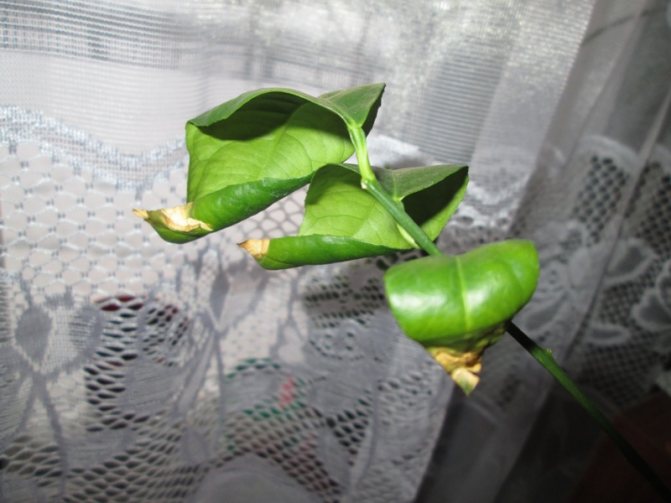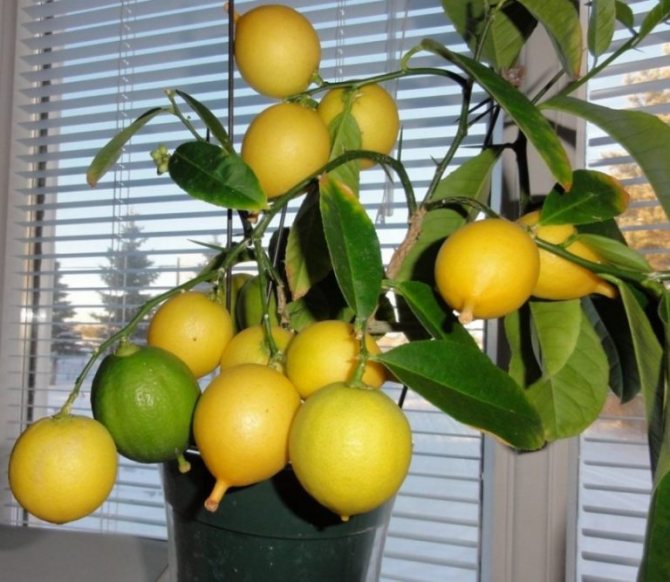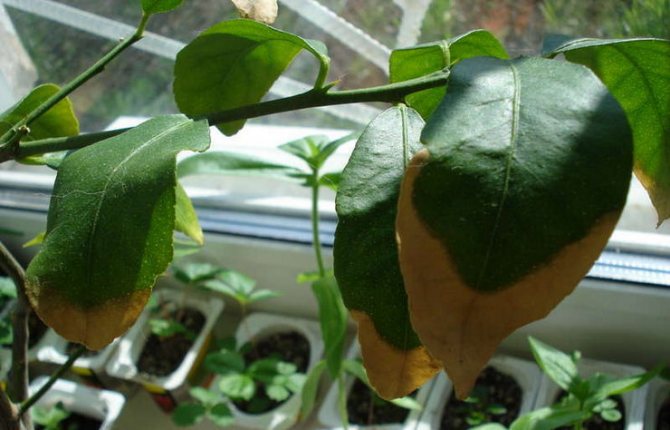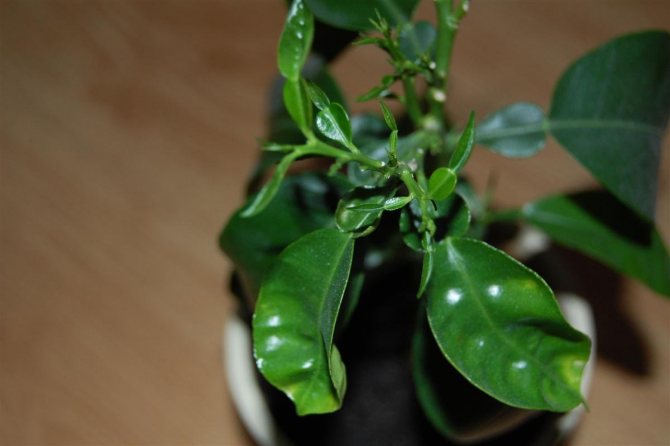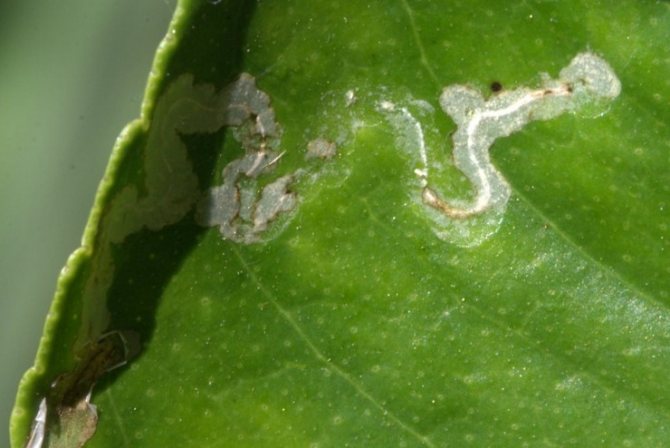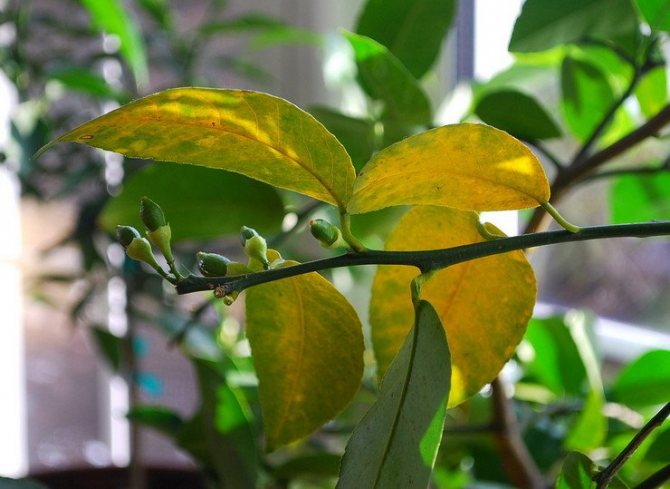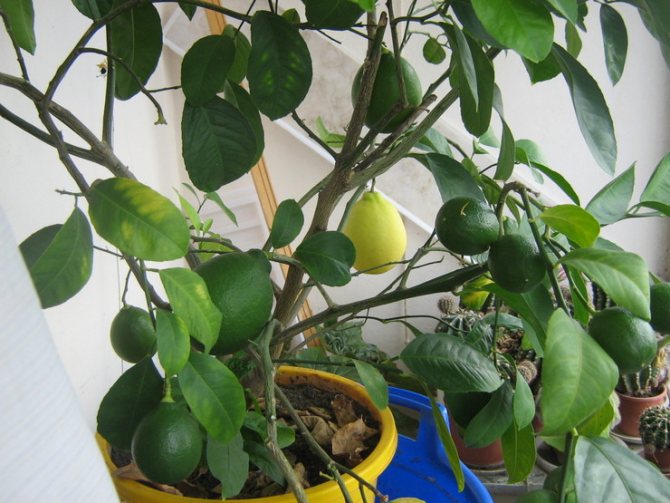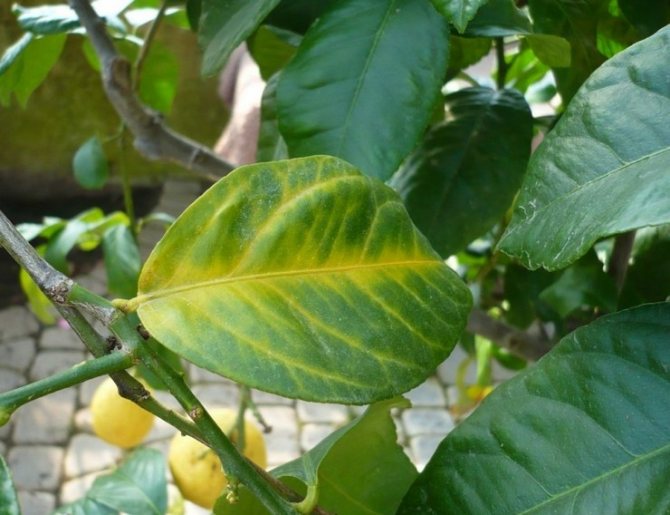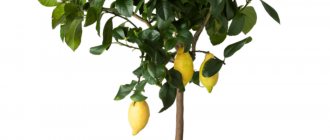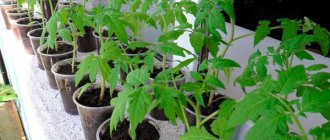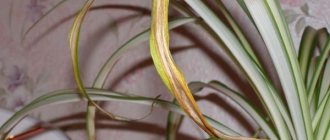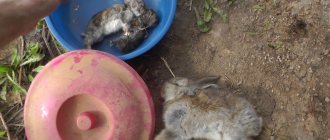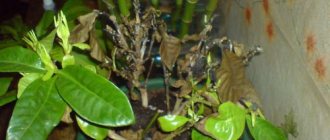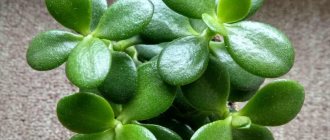Horticulture »Citrus» Lemon
0
993
Article rating
Lemon is a hybrid evergreen citrus plant. It is cultivated indoors for fruit and for decorative purposes. The plant is whimsical to growing conditions, but it is resistant to diseases. If lemon leaves fall, this is a symptom of a violation of the rules of care.
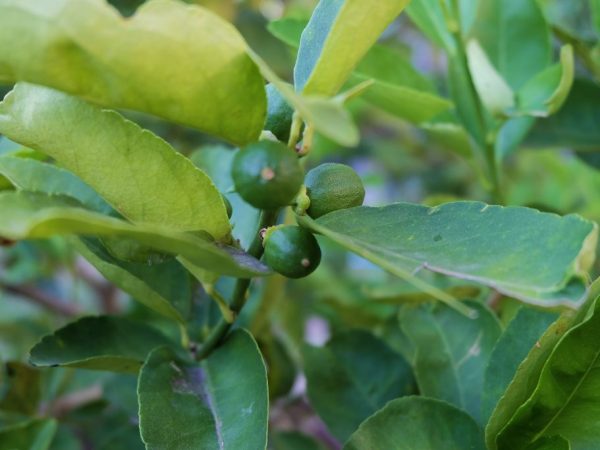
Reasons for falling leaves in indoor lemon
Causes of foliage loss
Indoor lemons lose green leaves for the following reasons:
- insufficient lighting;
- excessive soil moisture in the pot;
- lack of sufficient nutrients in the soil;
- dry indoor air;
- excess of applied fertilizers;
- incorrect transplantation into a new container;
- insufficient amount of water;
- low ambient temperature;
- a sharp change in the place of cultivation;
- temperature drops.
Lemons are conditionally deciduous plants. The loss of foliage in winter is not a natural process, but a symptom of the influence of external factors on the plant. The presence of one problem causes slight loss of leaves and their yellowing. If lemon leaves fall, then there are several negative factors.
Pest control
Pests are another possible reason for indoor lemon greens to fall off. Knowing the basic rules of treatment, it will not be difficult to save citrus.
Insects feeding on the sap of the plant lead to leaf fall. They deprive plants of moisture and nutrients. Three types of such pests are most often found at home.
Spider mite


Spider mite is a small pest that often infects plants at home if the air in the room is not humid enough.
The presence of a spider mite is indicated by twisted leaves covered with cobwebs. The pest itself is also easy to find on the seamy side of the leaves.
Fight spider mites as follows:
- The tree is sung under the shower with warm water. The soil is covered with a film so that the chlorinated liquid is not absorbed into it.
- Lemon is sprayed with soapy water, ash infusion or insecticide. Particular attention is paid to the seamy surface of the leaves.
- After three days, the plant is washed again under the shower, washing off the remaining soap solution.
- The procedure is repeated at least 3 times.
Aphid
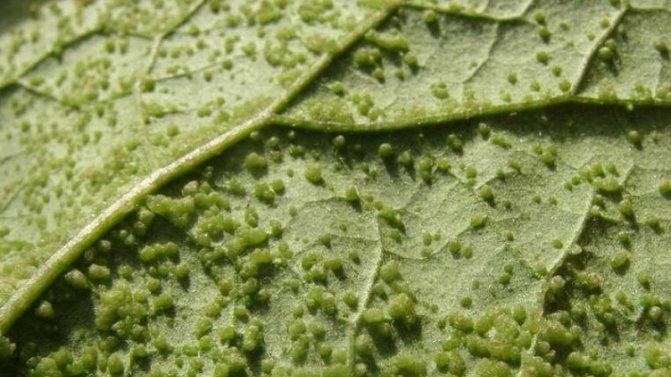

Aphids feed on plant sap, causing leaves to fall off. It infects lemons with whole colonies. Due to the abundance of insects, it is not difficult to spot them.
Aphids are located on young shoots and on the seamy side of the leaves. The affected areas wither and die.
How to get rid of aphids:
- All leaves and shoots, on which a large number of insects are found, are cut off from the tree. The withered leaves are torn off.
- The lemon is washed in the shower. The earth is covered with a package.
- Each leaf is wiped with soapy water with the addition of hot pepper or ash. Do the same with young shoots. The solution is also poured into the ground.
- After 5 days, the citrus is rubbed with clean water. Then the dreams are sprayed with soapy water. The procedure is repeated 1 more time.
Shields
Larvae of scale insects (small bugs) are attached to the bark or seamy side of leaves along the veins. From above they are covered with a strong chitinous layer.
To eliminate them, the following procedures are carried out:
- If possible, areas of the plant with a large number of scutes are removed.
- Prepare a mixture of equal parts of kerosene and water. The resulting composition is used to wipe the parts of the plant on which the scale insects remain.
- The tree is sealed with a bag for 2 hours.
- After 2 hours, the plant is washed under the shower.
- Repeat the procedure if necessary.
Influence of light
Improper lighting is one of the most common causes of foliage in home trees. The main time of lack of light for lemon is winter. During this period, the fruit needs more ultraviolet radiation, since the air in winter is cold and less humid.
Lemon lighting rules in winter:
- Location. The plant thrives on a windowsill on the south or east side. It is forbidden to grow indoor lemon near heating appliances: they will cause drying out and loss of foliage.
- Using mirrors. To prevent the sheets from drying out, they are placed around the plant. This is how they reflect the sun's rays. As a result, the lemon receives a sufficient amount of ultraviolet radiation.
- Lighting. If it is not possible to provide indoor lemon with natural lighting, artificial lighting is used. For this, the plant is illuminated with special ultraviolet lamps or daylight devices.
If the lemon has dropped its leaves in warm seasons, change its place. Choose a window sill that receives direct sunlight for at least 3 hours a day. In summer, the plant is taken out onto the terrace or balcony.
How to save a lemon tree
There are more chances to save a home-grown crop with the timely detection of signs of drying out of the leaves. When the lemon is just starting to dry, it still resists the effects of harmful factors - it will turn out to revive it faster.
All measures for the improvement of indoor citrus are also preventive methods, because the treatment and prevention of damage to leaf plates are performed by similar actions. The only exception is the infection of the plant with fungal and viral diseases, as well as the attack of pests.
It will be possible to cure citrus from diseases at home using copper-containing formulations.
It is impossible to fight Molsecco's disease. For such a pathology, effective means and methods of treatment do not yet exist.
Organization of correct lighting
Lemon is a tropical plant. He loves moisture and sunlight. The light should be diffused, characteristic of the dense thickets of the tropical jungle. Direct sunlight leaves burns on the leaf plates, which is why their surface begins to transform, becomes dry and rough.
To save a house tree, you will have to take several important measures. The citrus owner needs:
- Organize 12 hours of daylight hours. Supplementing is carried out with phytolamps.
- Install the container on the south, south-east or south-west windows.
- Protect the deciduous mass from direct sunlight with a cloth or special reflective foil overlays (they are attached to window panes).
All sun-damaged foliage will have to be removed. Dried leaves cannot be restored. It is easier to make room for the germination of young green mass.
Correction of errors in the organization of irrigation
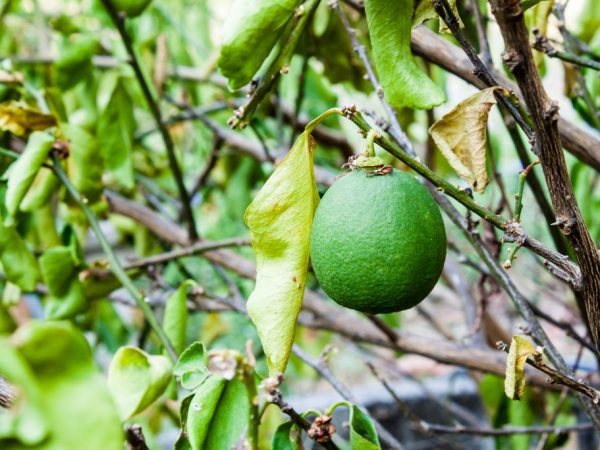

Overflow can lead to root rot
Lemons love moisture and react poorly to lack and excess. The plant is watered in small portions of warm water, avoiding the accumulation of excess liquid in the pan. They are guided by the state of the soil in the pot. Citrus is watered as soon as the earthy clod becomes dry.
With overflows, the roots of the culture suffer. They rot and gradually die off, depriving the tree of nutrients. As a result, the structure and color of the foliage changes, it dries and falls off. With such signs, they act decisively:
- extract the citrus from the pot;
- carefully remove the earthen lump and rinse the roots with running warm water;
- examine the root system for damaged tissues (all rotten processes are removed);
- treat the cuts with charcoal or other antiseptics.
After the performed manipulations, the citrus roots are dried for up to 30 minutes, and the lemon is planted in a new substrate with a good drainage system (up to 1/3 of the total volume of the pot).
Temperature normalization
With sudden cold snaps and frostbite, the lemon tree can quickly lose its leaves. Even an ordinary draft can have a detrimental effect on culture.
When exposed to critical temperatures, they stabilize the indoor microclimate. The favorable temperature for citrus content is 18-22 ° C. With careful care, the tree will grow quickly and grow into new healthy deciduous mass.
Air humidification
If citrus foliage begins to dry around the edge and curl, it suffers from dry air. The normal moisture content for the content of this culture is 60-70%. With any deviations, she is sick.
Freshening a flower in a pot will not be difficult. The following measures are beneficial:
- Spraying the foliage and tree trunk regularly with warm water, and rubbing the foliage daily.
- Covering heating devices with a thick cloth or foil: they contribute to overdrying the air near adjacent windows.
- Installing vessels with water next to a tree.
Watering
Homemade lemon sheds its leaves due to over-watering. This causes stagnation of water in the ground, waterlogging occurs. The soil becomes not loose enough. The roots do not receive the required amount of oxygen. This causes stress on the plant, which is determined by the fact that the leaves have fallen.
As a result of waterlogging in a houseplant, roots and capillaries die off. Root nutrition is impaired, which affects the condition of the tree crown. New shoots are not formed, and there are not enough useful elements to maintain the old ones. The leaves begin to turn yellow and fall off. Also, waterlogging causes the appearance of fungal diseases of the roots and branches of the tree.
Lack of moisture
A small amount of added moisture also negatively affects the lemon. Drying and curling of leaves is a symptom of the drying out of the soil layer. Dead leaves of homemade citrus fruits gradually fall off, and there is not enough moisture for the development of new ones.
With a lack of moisture in the roots, their endings die off. The circulation of juices in the trunk and branches deteriorates, the plant enters the stage of stress and dies. Flowers and ovaries do not appear.
To restore the condition of the lemon. if the leaves have dried up, restore watering. It is impossible to abruptly introduce moisture into the dried soil: this will lead to an excess of water in the root system and, as a result, to disease.
The lemon tree is reanimated gradually. Before watering, the foliage is sprayed so that the crown is saturated with moisture. Then moisture is gradually introduced into the soil. Its amount is increased with each new application, until the normal state of the lemon is restored.
Lemon leaves have white spots
The reason for the appearance of white spots on the leaves of lemon is powdery mildew. It is not difficult to treat this disease if it is detected at an early stage. The disease can affect both old and young lemons.


Powdery mildew
As the fungal disease progresses, the symptoms change. At first, the leaves turn yellow and curl, then a white bloom appears. The plant stops developing. New shoots do not appear, old foliage falls off. In order to prevent the development of the disease, lemons are regularly taken out into the fresh air in summer, and in winter the room is ventilated several times a week.
If powdery mildew does appear, you need to immediately start treatment. The affected leaves are immediately cut off and discarded. The rest of the plant is sprayed with fungicides (for example, Skor or Horus). Copper sulfate treatment is also effective.
Climate
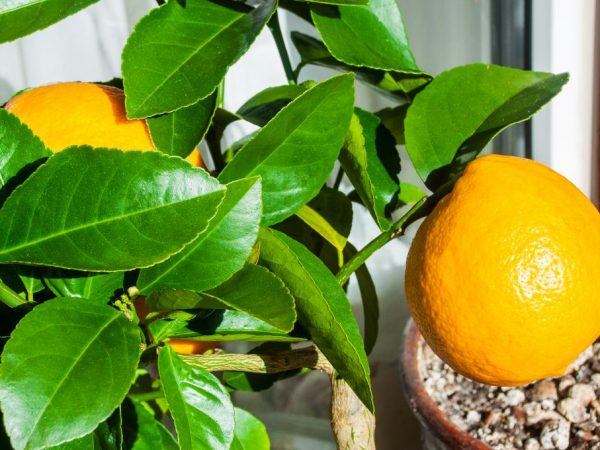

Spray the plant regularly
Young citrus requires constant spraying of the crown under normal conditions. A suitable temperature for the development of a houseplant is 18 ° C-20 ° C. In the hot season, plants are sprayed 2-3 times a week.
In winter, the number of procedures depends on the power of the heating devices. If the air is warm, and the plant dries and throws off the leaves, spraying is carried out daily. At a cool temperature, 2-3 procedures are performed per week.
If moisture is not brought in on time, and the air is dry, the leaves will fly around. To revive it, the plant is regularly treated. Also, room lemon is placed away from heating devices or covered with a cloth during the day. Lack of moisture will stop buying a humidifier.
Cold air
In winter, lemon feels fine at a temperature of 12 ° C-14 ° C. In colder air, the plant sheds its leaves. Growing lemon in the winter on an unglazed balcony or street is prohibited.
In order to restore a plant, it cannot be abruptly brought into heat. Lemon does not tolerate sudden changes in temperature, and therefore will lose even more leaves from the crown.
The room temperature is increased gradually. During the care, the condition of the leaves and shoots is carefully monitored. If they look better, increase the temperature slightly. Also, the tree is protected from drafts.
Why does the plant shed its leaves
Citrus fruits familiar to us - lemons, tangerines, oranges - come from the humid subtropics. Their habitual climate is humid, sunny summers and moderately warm winters. Lemons are conditionally deciduous plants, they are able to bloom and bear fruit all year round and only suspend growth in winter. Indoor lemon varieties are "domesticated" more than other citrus fruits, that is, they get used to the microclimate of apartments more easily.
Lemon leaves are its "pantry", a strategic supply of nutrients. Young shoots grow due to the nutrition accumulated by adult leaves. The more foliage a tree has, the more weighty the crop that it will feed. Therefore, our task is to preserve foliage as much as possible.
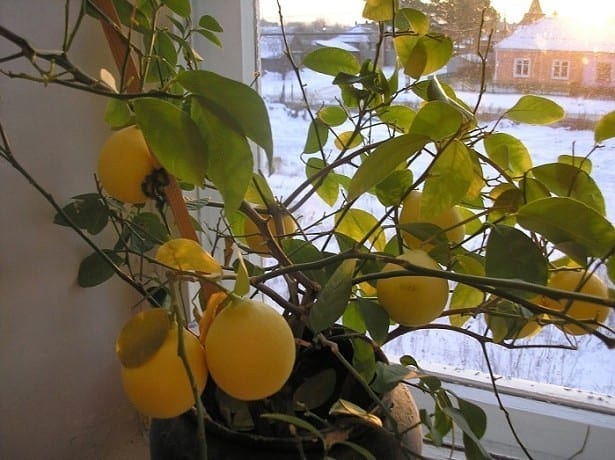

Let's see what happens to lemon in the room. Illumination with the onset of autumn drops sharply, the plant does not have enough light. Cold air flows from the windows. At the same time, radiators drive dry hot air upward. The lemon tree perceives bad conditions as stress, reacting to them with leaf fall. Thus, winter is the most dangerous period in the life of lemon and other citrus fruits.
Why does lemon shed its leaves? Main reasons:
- adaptive stress;
- poor lighting;
- heat and dryness of the air;
- excessive watering;
- insufficient watering;
- temperature difference;
- lack of nutrients;
- diseases and pests.
Soil depletion
Soil for growing lemons should contain:
Also, the plant requires regular application of phosphates and natural fertilizers from humus, deciduous soil, peat and ash. They are needed for the active growth of shoots, maintaining the crown, the appearance of the ovary and fruits.
Signs of a lack of nutrients in the soil:
- the appearance of yellowness on the leaves;
- withering of the crown;
- changing the shape of the sheet;
- drying of shoots.
If the soil is not saturated with minerals in time, the tree will lose its foliage, and the fruits will stop developing. To prevent the bush from shedding foliage, top dressing begins to be applied regularly.
In the summer, mineral fertilizers and organic substances are applied 2 times a month. In cold seasons, top dressing is applied once a month. If the tree does not bloom, no phosphorus is added.
Lemon home care, leaves turn yellow
When caring for a lemon, do not forget to regularly inspect the plant, as diseases or parasitic infections can occur suddenly and develop very quickly, leading to yellowing and leaf fall, and in neglected forms, to the death of the tree.
Lemon pests


Spider mite infested lemon
- Aphid. Signs of damage are active yellowing of leaves, sometimes even whole branches. Pay attention to the inside of the sheet. If insects have just appeared, and there are few of them, just collect the pests by hand. If the disease is neglected and the colony has grown, Tanrek will help.
- Spider mite. It is also easy to identify: small cobwebs begin to appear at the bases of the leaves, and the leaves themselves turn yellow and curl. Fitoverm will help to defeat the parasite.
Lemon leaf disease
Houseplants get sick much less often than garden plants, however, improper agricultural technology for growing lemon, the use of contaminated soil or poor-quality vaccination can lead to infections that are very dangerous for the tree.
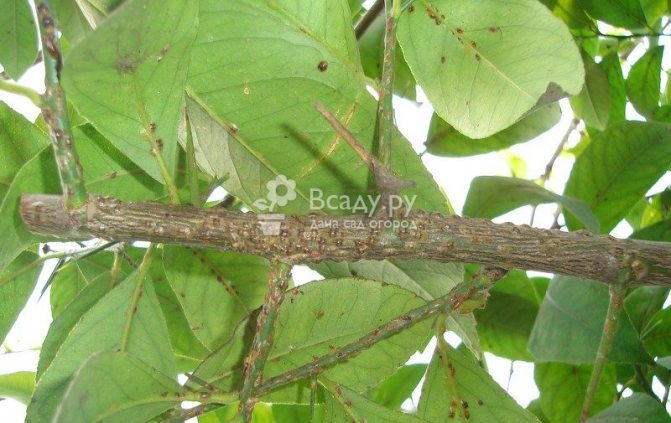

Gommosis-infected lemon leaves and stem
Malsecco's disease
The periods when the plant is most susceptible to it: spring and autumn. It manifests itself in the fact that the leaves acquire a red-orange hue and slowly die off. Moreover, only they disappear, while the petioles remain on the branches. Unfortunately, there are no methods to combat this disease yet.
Gommoz
If you do not start to treat lemon in time, indoor diseases can completely destroy the tree. It develops on the bark of a tree, leading to its decay, and then infects the leaves. Initially, it manifests itself in the form of brown sticky drops flowing down the bark of the stem. The affected area must be cleaned and treated with copper sulfate, and the plant itself must be transplanted into new soil.
Outcome
Caring for indoor exoticism is quite troublesome, but observing the rules and recommendations of agricultural specialists, you can protect the plant from diseases and parasites and create the most favorable conditions for the growth of a healthy and fruiting lemon.
Pests and diseases
Lemons also drop leaves when infested with pests:
- Shield. She feeds on the sap of the tree, which causes a lack of them in foliage. The symptom of the disease is small holes in the leaves.
- Aphids. It feeds on substances from the leaves, which causes them to wilt and dry out. Identified by the presence of small black dots.
- Spider mite. Appears during the flowering period. Identified by the spider web on the branches.
The actions of pests cause the plant to dry out, its leaves crumble. Chemicals are used to fight, as well as folk methods. A decoction of garlic and onion skins helps a lot.
What is Lemon sick
Lemon is an evergreen plant from the genus Citrus, and the fruit of this plant also bears this name.
Citruses are often susceptible to disease. Let's consider the most common ones.
If the leaves turn yellow, bumps appear on them and they fall off, then most likely small pests have settled on them. Them called scale insects and false scale insects... Outwardly, they differ from each other only in size. The scale insects spread throughout the plant and begin to actively suck out the cell juice from the citrus. These pests are active all year round and secrete mucus, which is a breeding ground for the sooty fungus. Externally, the scabbard looks like brown tubercles on the trunks, leaves. And they leave behind a brown waxy coating.
NOTE! Tree infection can occur by ingestion of larvae from the ground. Also, purchased flowers, fruits or other recently purchased indoor flowers can be a source of infection.
To fight it is worth using mechanical, chemical or folk methods.
The mechanical method is used to completely remove parasites from citrus.
The chemical method is also effective in killing the larvae.
Folk remedies in combination with a mechanical method will help to destroy more adults.
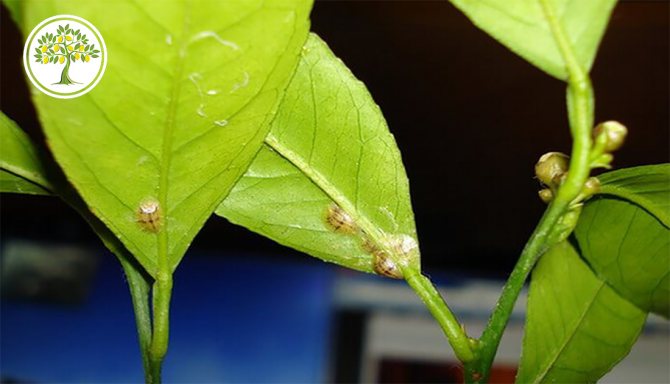

Scabbard on lemon leaves looks like small bumps
Spider mites are another type of parasite.... They feed on the sap of the plant, depriving it of its vitality.First, yellow dots appear, yellowing at the base, folding. And later, a cobweb is observed on the affected sheets. To combat this insect, you need to wash the tree with laundry soap, after putting the bag on a pot of soil. After that, you can treat the leaves with chemicals. But the chemicals will not help fight the eggs laid by the mites. Therefore, the treatment will need to be repeated periodically. To fix the result, place geranium or garlic next to the lemon, the pests do not tolerate their smell.
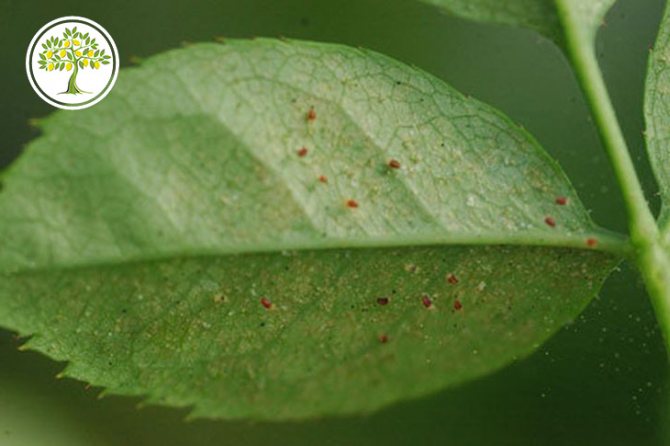

Spider mites are difficult to spot on leaves due to their small size
Aphids are another parasite that lives on lemons.... It is difficult to find it in early steel, since it has a yellow-green color. Aphids attack the leaves and stems, which causes yellowing and deformation of the leaves, even drying out of whole branches. You can fight it with chemicals or folk remedies. The easiest way is to wash the leaves and stems with laundry soap. Another common method is dichlorvos. Wears a package on Lemon
Lemon is an evergreen plant from the genus Citrus, and the fruit of this plant also bears this name.
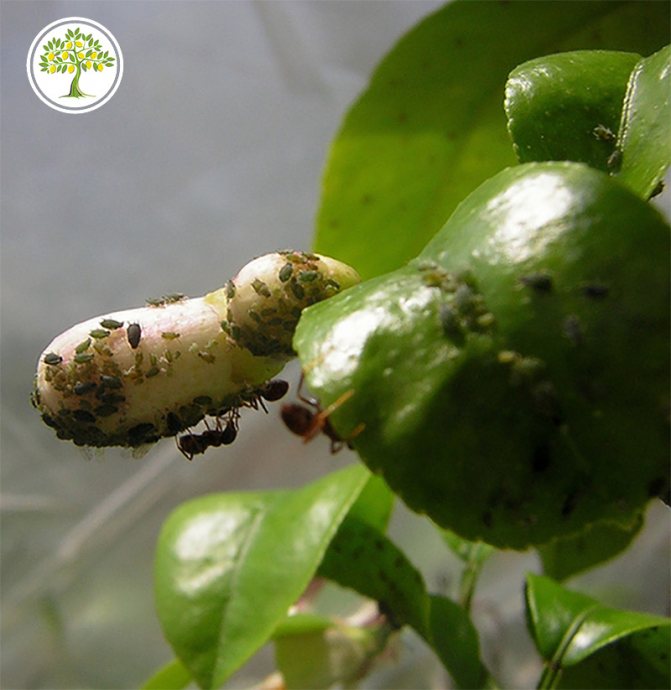

Aphids eat the lemon blossom and its allied ants
Why lemon leaves turn yellow and fall off
For the development of plants of the citrus family, good lighting, a certain air humidity and a favorable climate, close to tropical, are required. It is quite difficult to achieve this at home, so a slight discrepancy between the watering regime or the amount of sunlight can pretty much spoil the leaves and twigs of the lemon.
The most common causes of dropping and yellowing of citrus leaves are:
- diseases and pests;
- dry air;
- lack of food or improper watering;
- change in temperature or drafts;
- improper or insufficient lighting.
Pests can appear on the lemon when the plant is taken outside. If pathogens in the room are not able to reach the plant, then even a few minutes in the garden makes it vulnerable.
The main signs of citrus infestation are:
- the appearance of small holes on the leaves, which increase over time;
- yellowing of leaves around damaged areas of the plate;
- the presence of scales, plaque or insects on the lower part of the leaf.
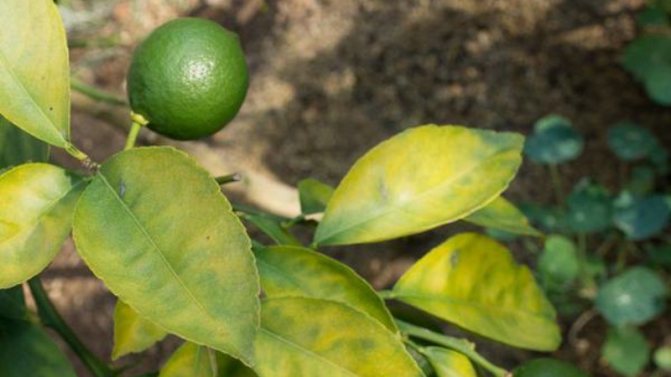

The soil in the plant pot should be hermetically covered with cling film or ordinary oilcloth to protect it from the external environment. Wash each leaf in a mild soapy solution (potash or laundry soap) with the addition of fine-grained ash.
Lemons have many different diseases that can be distinguished by the following:
- change in the color of the ends of the branches to a red-orange hue, the release of dark brown juice;
- the appearance of cracks in the bark;
- changing the color, size or shape of the sheets.
Viruses, bacteria, or fungi can be the culprits for these symptoms. Moreover, it is impossible to cure citrus from viruses.
Particular attention should be paid to the appearance of the plant before purchasing. Any damage or color mismatch can not only ruin the lemon, but also infect other plants.
In the homeland of citrus fruits, the climate is humid and warm. While it is much easier to maintain the optimum room temperature, it is much more difficult to provide the necessary humidity. Even a slight discrepancy with the usual air humidity for lemon can ruin the appearance of the plant.
Excess moisture in citrus soil affects its development. From the petiole of the plant, then, yellowness will spread throughout the trunk, followed by dropping of all the foliage.
To determine the moisture level of the soil, you should slightly remove the top layer.
Temperature jumps for citrus are no less destructive than other unfavorable factors.Therefore, the lemon should be protected from drafts and drops. The plant reacts by shedding green leaves or slightly yellowed ones, twisted around the edges with a brown border.
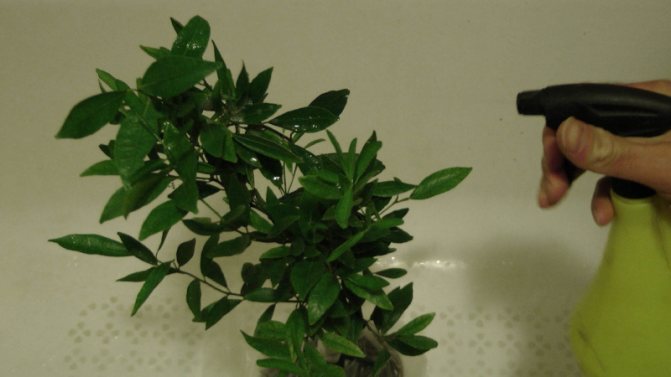

Diseases and their treatment
Dropping the leaves of a citrus plant is not always associated with a violation of the rules of care and unfavorable indoor conditions. Often the problem arises from the lesion of the lemon with diseases. Finding them in most cases is simple, it is enough to know the characteristic symptoms.
Most diseases are easily treated at an early stage. If symptoms are detected too late, then most often the plant dies.
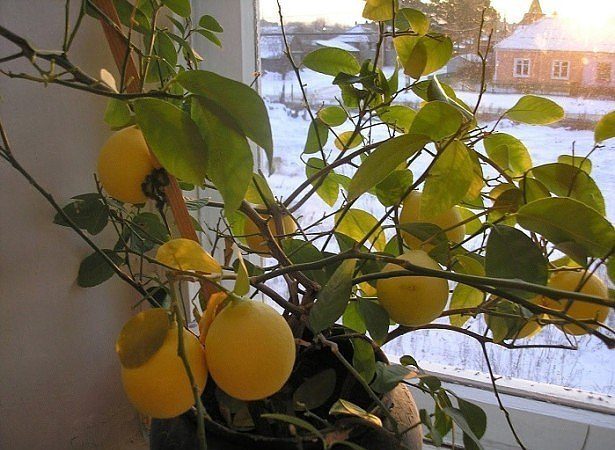

Gommoz
Hommosis is a fungal disease that affects the branches and trunk of a plant. The reproduction of a fungal infection provokes excessive humidity in the air and soil, damage to the bark, deepening of the root collar, and an excess of nitrogen.
The symptoms of the disease are as follows:
- brown spots are formed on the branches and trunk;
- the affected areas die off and crack;
- gum appears from the lesions (a sticky, quickly solidifying mass of golden color).
With gommosis, sap flow is disrupted, due to which a sufficient amount of nutrients does not enter the leaves. They wither and fall.
What to do to save lemon from gommosis:
- All spots on the bark of the plant are cut off with a sharp, disinfected knife. If there are too many lesions on the branches, then they are removed.
- The cut areas are treated with a 3% solution of copper sulfate. Then the whole plant is sprayed with the agent.
- Places of cuts are covered with garden pitch.
The treatment is repeated three times with an interval of 7 days or until the symptoms of the disease disappear.
Root rot
Root rot is another fungal disease. It affects the roots, so the problem is usually noticed when the lemon is already beginning to shed its leaves.
The cause of the disease is considered to be waterlogging of the soil, watering with cold water, deepening of the root collar, planting in contaminated soil.
To get rid of the disease, the following methods are used:
- The tree is dug up. The roots are cleared of the earth.
- The root system is examined. Remove all affected parts.
- The roots are treated with a solution of potassium permanganate or copper sulfate. Soak in the solution from the need for at least half an hour.
- The tree is transplanted into disinfected soil.
A week after transplanting, avoid watering the lemon at the root. Instead, the crown is sprayed daily. After a week, the lemon is watered with a root stimulant.
Tristeza


Tristeza is a viral disease. Loss of foliage is considered its first symptom. Then the shoots and bark of the plant die off.
Weakened lemons are infected with the disease. It is carried by insects and some types of citrus fruits.
Tristeza is not cured. The infected plant dies.
Melseco
Melseco is another incurable disease. Its main symptoms are shedding of foliage and staining the cut of branches red. Develops with improper care.
Anthracnose
Anthracnose is a disease caused by a fungal infection. It often infects plants at home and causes shedding of foliage.
The list contains its signs:
- leaves turn yellow and fall off;
- the plant sheds inflorescences and buds;
- young shoots die off;
- red spots appear on the set fruit.
To cure the plant, all affected leaves and shoots are plucked from it. The tree is sprayed with "Fitosporin" or 1% solution of Bordeaux liquid. Processing is carried out at least 3 times.
Massive and abrupt fall of green leaves
In addition to the wrong feeding or watering regime, the disease gommosis can provoke a sharp and massive fall of citrus leaves. The main symptom is the appearance of a light brown sticky liquid in areas of the dying bark.
Citrus can be saved with the help of various fertilizers and dressings, including mineral formulations. The main thing is that the plant receives boron, potassium, phosphorus and iron.
Top dressing should be moderate.Abundant fertilization leads to a sharp drop of all the leaves of the lemon.
Watering the plant correctly:
- water for irrigation should be warm;
- watering is necessary often, but in small portions;
- overdrying the soil is unacceptable;
- monitor the patency of the holes in the bottom of the pot;
- the volume of the drainage fill should be up to a third of the total soil.
If the process of decay of lemon roots due to an excess of moisture is started, the plant should be transplanted immediately. After cutting off all damaged roots, it is necessary to treat healthy areas with a weak solution of potassium permanganate. The tree should be planted after the rhizome has completely dried.
Immediately after transplanting citrus into a looser pot, the plant will begin to develop roots, and only after a certain time will new leaves appear.
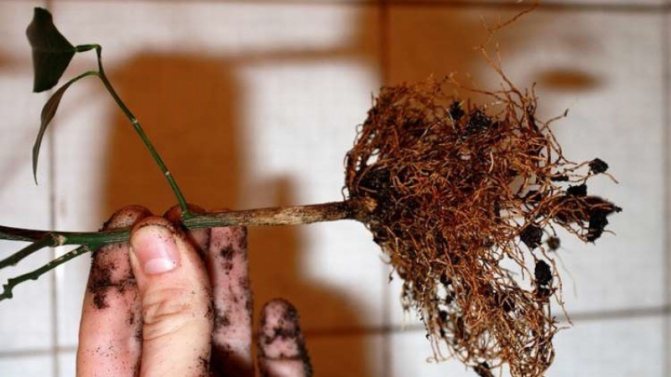

Sticky coating on lemon leaves
Diseases of roses - treatment and pest control
Sticky plaque is not always a sign of illness or the appearance of a pest. It is possible that plaque stands out due to improper watering. In the natural environment, sticky plaque appears to attract ants, which, in turn, destroy pests on the tree. If a sticky coating appears on homemade citrus fruits, do not panic right away.
Pests of indoor lemon, due to which a sticky coating appears:
- shield;
- aphid.
The scabbard is dangerous because, if it is not noticed in time, the citrus will die. If a sticky bloom appeared on the tree, the plant began to dry out, and specks appeared on the foliage and stems, then this is a scale insect. Treatment with Fitoverm and Aktara preparations helps from the pest. For the complete destruction of the pest, 3-4 treatments are required with an interval of 2 weeks.
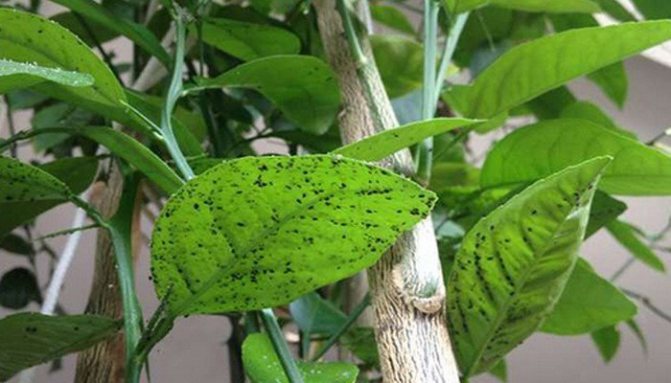

Aphids on citrus
The second cause of sticky plaque is aphids. Finding a pest is not at all difficult. These are small green bugs that can be seen both on the foliage and on the rest of the plant. To destroy the pest, every day for a week, citrus is sprayed with a solution of laundry soap. You can also use garlic water. You need to spray every day for 5 days.
Blackening and reshaping of lemon leaves
Changes in the shape or color of the leaf plate cause several reasons. First of all, it is worth checking for the presence of wartiness in the plant, which appears due to the increased temperature and humidity around the lemon. Treatment in this case is reduced to the elimination of damaged areas and their treatment with Bordeaux liquid in March, after the lemon has flowered and in mid-July.
Reduced phosphorus content in citrus soil leads to darkening of the foliage. Corrected by applying the appropriate mineral fertilizers. Corrugated leaves indicate a lack of potassium. The plant recovers after fertilizing and watering with potash water. Mosaic light strokes on the leaf plates signal the leaf mosaic. The tree stops growing and releases deformed leaves. It will not be possible to cure the disease, but special fertilizers will reduce the negative manifestations.
Late blight is manifested by a light bloom below the leaves and darkened spots on the plates. Lemon can be healed by removing damaged areas and then treating them with copper sulfate.
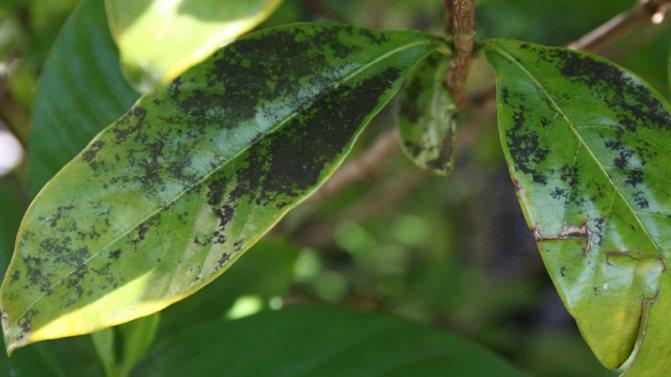

Mandarin leaves turn yellow
Many gardeners are faced with the fact that mandarin leaves turn yellow. Most often, the reason lies in the lack of minerals. So, with a nitrogen deficiency, the lower leaves of the citrus first turn yellow and gradually all the rest. To replenish nitrogen in the soil, nitrogen mineral fertilizers are used, for example, ammonium nitrate or ammonium sulfate, or organic fertilizers. With a lack of iron, the leaf plate acquires a light yellow color, chlorosis develops. Chlorosis first covers young leaves, then spreads to old ones. To prevent this disease, the plant is treated with iron chelate once a month.Insufficient light or too small a pot can contribute to yellowing of the plate. The problem can be solved by transferring the plant to a larger pot with fresh nutrient soil.
Curling and drying lemon leaves
The main signs of a plant's reaction to dry air is the yellowing of the tips of the leaf plates, followed by their drying. If measures are not taken, then yellowness quickly spreads through the tree, provoking its pallor, drying and dying off. This problem can only be prevented. To do this, you should, as often as possible, spray the citrus with plain water from a spray bottle.
The lemon bush must be surrounded by a "cloud" of moisture at all times.
To increase the humidity, wet pieces of sphagnum, peat or expanded clay are placed on pallets around the lemon. Water containers will also create additional moisture, as well as batteries covered with wet towels. Frequent use of a steam generator, humidifier or ionizer has a beneficial effect on the microclimate. Setting up a miniature greenhouse around the citrus will significantly increase the moisture level around the plant, as well as reduce the need to constantly spray it.
Similar signs are caused by the xylopsorosis virus, which makes it difficult to identify pathology. If a lemon is infected with this particular virus, it should be thrown away to prevent other plants from becoming infected.
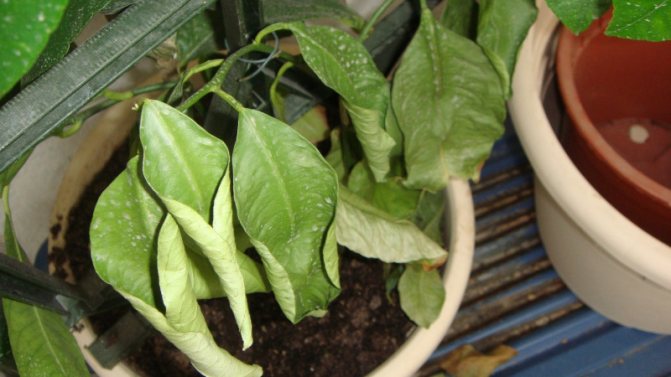

Preventive measures
It will be possible to avoid yellowing and falling foliage with properly organized home care. The owner of the citrus will need to control the level of temperature and humidity of the air, water and fertilize the crop in a timely manner and correctly, and carry out preventive spraying against diseases and pests.
To prevent yellow spots from appearing on the foliage, a warm tropical shower is arranged for the lemon. The plant is washed with a diffused stream for several minutes and set to its original place of detention.
Other preventive measures to help avoid yellowing of foliage:
- Supplement citrus with phytolamps in winter.
- Protect the tree from the harmful effects of heating devices.
- Open windows in winter for several hours.
Why do branches dry and leaves fall
Problems with the drying of citrus leaves and twigs appear if the plant is located in a too dark place, as a result, it suffers from stagnant water in the soil, lacks moisture in the air. After normalization of conditions, the appearance of the lemon should be restored.
In addition to excess or lack of moisture, drying of branches can provoke spider mites. Insufficient amounts of potassium, phosphorus or nitrogen in the soil can also cause this problem. The introduction of top dressing with all the microelements necessary for citrus will help to recover.
Why lemon does not bear fruit
Reasons why lemon does not bear fruit:
- Wrong vaccination. If the plant was grown from a seed, it will never bear fruit. Lemon can be grafted onto other varieties of lemons, orange or grapefruit.
- Temperature violations. If the vaccination was carried out successfully and the tree bloomed, and then all the inflorescences fell off, then the problem is in the air temperature. The most favorable temperature is 23-25 degrees.
- Low humidity level. The humidity level in the room should be 70-80%.
- A large number of inflorescences. If there are many inflorescences on a tree, they take a lot of energy from it and, as a result, no fruit is formed from a single flower. You need to immediately pick off small flowers.
- Lack of nutrients in the soil. As soon as the lemon began to bloom, fertilizers for citrus plants are applied to the soil.
Important! In order for a lemon to bloom, it needs conditions as at home in tropical forests: high humidity, a lot of diffused sunlight and regular fertilizing with complex mineral fertilizers.
Why does lemon fall off young leaves?
Young leaves that have not even changed color or shape may fall off due to temperature fluctuations in the room.
Prohibited:
- leave the windows in the apartment open at night;
- arrange drafts;
- install a lemon near radiators or other heating appliances;
- immediately change the temperature in the room by several degrees;
- open the window near the citrus.
Lemon is a heat-loving and sun-loving plant. However, direct rays are dangerous for him and can damage the delicate skin of the leaf plates. Small yellowish dots on the leaves with their subsequent increase are considered a sign of improper lighting. To fix the problem, you need to provide the citrus with diffused light or good lighting with a reflective screen or backlight. The "burnt" plant should be moved to a darkened area of the room without picking off damaged leaves.
The plant is indifferent
It has already been said that lemon is not a fan of high temperatures. And in the hope he overwintered, he needs a low temperature regime. But this does not mean that the plant needs to be taken out, keep the balcony - on the street it will freeze completely. The most optimal thing is to provide it where it is not warmer than plus ten degrees. If it is colder, the lemon will simply throw off the leaves.
And when you see that the lemon is frozen, there is no need to hastily enter it into a warm room - a sharp change in temperature will affect the exotic inhabitant of the room destructively, and he will die. All you need to do is gradually raise the temperature around the tree - say, assign heaters.
You should carefully look at the fact that there are drafts in the unfavorable room. - they also lead to temperature changes. And now it is written that temperature drops have a negative effect on the lemon crown.
Reasons for falling ovaries and fruits
The fall occurs due to the lack of manganese and boron. Long-term presence of a plant in one pot or tub also leads to depletion of the soil. Signs of lemon "starvation" are reflected in the appearance of darkening on the leaves between the veins, while maintaining the emerald color of the veins themselves. Ignoring the situation will quickly lead to the death of the plant. Boron deficiency provokes the accumulation of toxins in the citrus, which poison the plant. Fertilizer complexes containing manganese and boron will help to cope with lemon diseases.
On the other hand, a young tree can shed its first fruits, which indicates its unpreparedness for fruiting. The removal of inflorescences before the age of five can help citrus. The tree also sheds fruit and color in case of "thirst". It is necessary to ensure that there are only a few flowers, since a small plant is simply unable to provide moisture to all the ovaries.
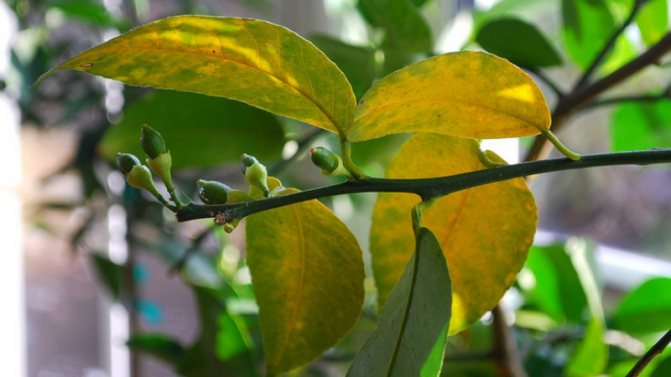

Temperature regime
Your lemon leaves began to curl at the ends and then turn yellow? Probably the reason is insufficient watering of the plant. It is best not to let the lemon soil dry out, because this can lead to the drying out and death of the plant. The soil in the pot should always be slightly damp. But if the soil does dry out, it needs to be moistened gradually, in small portions of water at intervals of several hours. Watering the lemon sharply after a "drought" can negatively affect the plant, and it will shed its foliage.
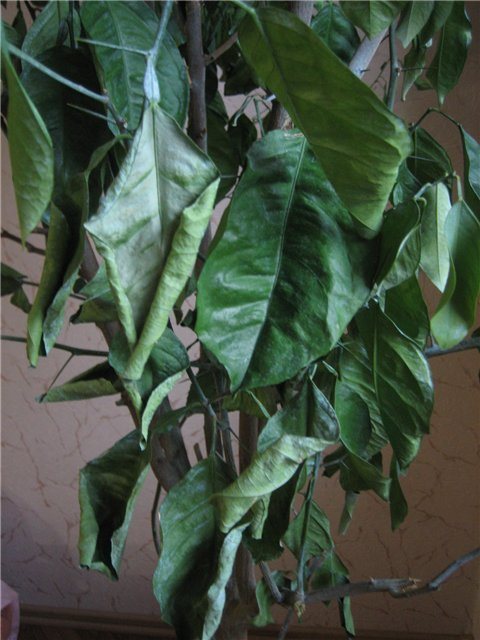

This happens if you do not water the lemon for a long time and dry the soil
Too much watering will also not have the best effect on the condition of the plant. With a large accumulation of moisture in the soil, the leaves turn yellow at their base, and not at the tips. The flooding of the plant adversely affects the state of the root system, it begins to rot, and because of this, the plant begins to ache and wither.


With excessive watering, the lemon leaf begins to turn yellow near the base.
To eliminate the effects of over-watering, the plant needs no more watering for several days so that the soil in the pot dries out.If there is too much moisture, it is imperative to transplant the lemon into a new pot, after drying the roots a little before planting. It is also important not to forget about drainage.
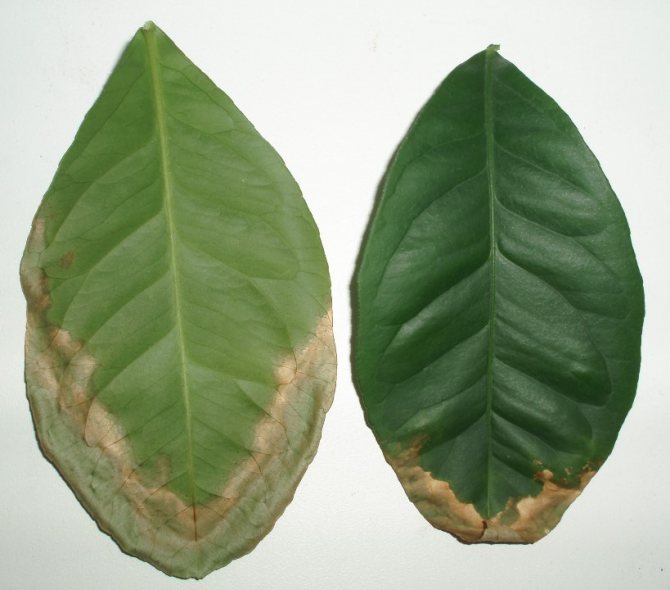

Signs of a regular bay in the lemon - the edges of the leaves darken, gradually turn brown, rotting of the roots is possible.
Water the lemon as the potted soil dries. The frequency of watering is determined by many factors: the size of the pot and plant, the temperature and humidity of the air, and others. In the summer, the lemon needs to be watered more often than in the winter: if in winter a couple of times a week is enough for the plant, then in the summer the number of waterings should be increased and the lemon should be watered every day or a little less often.
Read more: Ascariasis of pigs symptoms treatment prevention
What to do if a lemon suddenly flew
First, you need to find out the true reason for this behavior of citrus. If this is due to care errors, measures should be taken to eliminate them. Discovered diseases or pests are subject to treatment.
It is forbidden to rub the leaves, as their delicate surface can be easily damaged.
Pests should be carefully removed from the underside of the leaf. After a week, the procedure can be repeated as needed. The scabbard or whitefly is not afraid of soap solutions. To eliminate them, the use of systemic insecticides with a long-term effect is required. Sometimes re-treatment with chemicals is required. Before using it, you need to carefully study the instructions for the drug, check the expiration date and make sure it is stored correctly. Otherwise, the citrus tree may actively shed its leaves.
Bioinsecticides, which are safe for humans and animals, are the best against pests.
Not everyone manages to grow a lemon in an apartment and keep it healthy. The plant is capricious and very demanding to care for. Any errors in watering, lighting, microclimate in general can cause a complete shedding of leaves, their deformation, as well as a change in color. An accurate diagnosis will help to quickly restore the lemon to its previous healthy appearance.
Subtropical citrus plants are successfully grown at home today. Lemon is one of the popular plants, but it needs proper care to flower and bear fruit. If the leaves of the lemon turn yellow and fall off, then this is a signal of problems. In order for the plant not to die, it is important to know about the main reasons for such a deviation and how to correct the situation.
Diseases of indoor lemon
Leaf shedding can also be the result of infection of the plant with fungal diseases or parasites. Among the parasitic reasons why lemon leaves turn yellow, most often aphids and spider mites. Among the diseases is gommosis.
A spider mite most often develops in dry, hot air, characteristic cobwebs appear at the bases of the leaves, the leaves themselves turn yellow, curl, dry out. Fitoverm is well suited against a tick. It is possible, if the tree is small, to dip its green part in hot water, above 60 ° C.
A sign of aphid infestation is deformation, yellowing of leaves, drying out of whole branches. When there are a lot of aphids, it is difficult not to notice its colony, they concentrate on the back of the leaf. If there are few insects, then manually remove all the affected areas, if there are many - use Tanrek products and the like.
It happens that all of a sudden the lemon dropped the leaves. What to do in this case? Check if there is gommosis - the outflow of gum on the bark. Hommosis often results from other diseases that weaken the plant. It is with them that you need to fight. Moreover, most often, exclusively with drugs, folk methods are not very effective here. It is not always easy to determine what disease we have in front of us, so it is best to use complex drugs, such as Antracol, Quadris and others.
Reasons for the falling of the ovary and leaves
There can be a lot of reasons for the appearance of a sign of yellowing and falling leaves in a lemon, but in order to solve the problem, it is important to correctly determine it. If the plant throws off the green mass, then the rules of care were probably violated, it is in it that you need to look for the cause of the abnormal behavior in the first place. This situation can also be associated with the negative influence of environmental factors or pests.
Improper care
Any plant needs to comply with the rules of agricultural cultivation. Care consists in ensuring the correct planting and growing place, sufficient lighting and watering, and timely feeding.
Any mistake in at least one of the listed points is fraught with the appearance of lemon health problems.
Overfilling and underfilling
Excessive watering leads to acidification of the soil, as a result of which its compaction occurs, and the access of oxygen is significantly hampered. As a result of a lack of oxygen supply to the roots, the processes die off, which leads to insufficient nutrition of the lemon. Experiencing a deficit, the tree begins to get rid of green mass and shed foliage.
With insufficient soil moisture, the earth dries up, as a result of which the root processes also die off. The plant begins to experience problems with the movement of sap and sufficient nutrition, as a result of which a water saving program is activated, the result of which is shedding of foliage.
An adult plant is able to live in a state of stress with a lack of moisture for a month, but ultimately dies without correcting the situation.
The plant also reacts negatively to sudden changes in watering conditions. If, after a long drought, the tree receives sharply excessive watering, then the reaction to stress is the shedding of greenery. In case of excessive dryness of the soil due to the absence of a long watering time, the frequency of moistening should be restored gradually. For this, the soil is watered with small portions of water at intervals of 2 hours. After 2, resume the normal frequency of watering.
Watering with bad water
A common mistake made by beginner growers is to water the plant with tap water. As a result of such actions, liming of the soil occurs, salts accumulate in the soil, and lemons begin to wither. After saturation with salts, a white salt crust appears on the surface of the earth, which impedes the supply of oxygen to the root system. At the same time, it closes the drainage hole, blocking the possibility of removing excess moisture. Rain and melt water is considered the best for irrigation.
At home, warm boiled water is used for irrigation. The use of cold liquid is fraught with hypothermia of the roots. If possible, you can make reserves of water from a lake or spring, since in nature it is soft and does not contain a large amount of salt.
Poor or depleted soil
Lemon intensively consumes nutrients from the soil, therefore, over time, it causes depletion of the soil.
Cold or too hot air temperature
Excessively high temperatures in summer have a negative effect on lemon growth. The optimum temperature for plant growth is +17 C, for fruit ripening +21 C. Higher rates, combined with low air humidity, lead to leaves falling off. Lemon has a negative attitude towards changes, it is important for it about the same temperature of the soil and air. Foliage shedding is often observed in the autumn, when the tree is brought home from the open air.
Lack or excess of fertilizer
With a lack of nutrients, lemon leaves begin to turn yellow, changes are observed in the area of veins. Low flower formation and leaf fall indicates that there was too much of the possible applied complex of drugs.
The wrong place for the plant
In insufficient light, the lemon slows down in growth and can wither, therefore, sunny southern sides are chosen for its placement. In this case, in the summer it is necessary to shade the bush, preventing direct rays from falling on it. The tree does not like permutations, so you should think about its location in advance. It is recommended to turn it a little every 15 days so that the crown forms evenly on all sides.
Falling leaves due to care errors
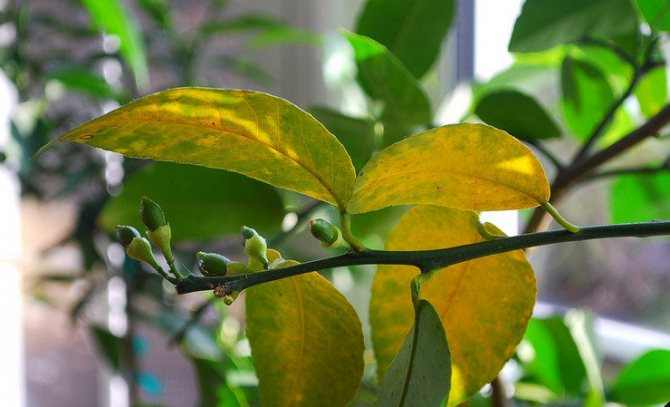

For evergreen lemon, massive leaf fall is unusual. It is normal for 1-2 leaves to fall, since the life span of one leaf plate is on average 3 years. Thus, the lemon leaves fall off one by one, and new greens grow in their place.
If the plant begins to fly around en masse, this indicates that it is experiencing severe stress. Often this is due to a violation of the rules for caring for him. To understand what to do if a lemon has leaves falling, it is worth understanding the reasons for this phenomenon.
Why Lemon Sheds Leaves:
- The room is too hot or too cold... Lemon is not suitable for extremely hot or cold climates. The permissible temperature for citrus plants varies between + 18 ... + 27 ° C. Optimum values are + 21 ... + 24 ° C.
- Sudden temperature changes. Lemon can't stand it. If you bring it to new conditions without preliminary hardening, it will begin to shed its leaves. Exposure to drafts is equally dangerous.
- Stagnant fluid. With excessive watering, lack of drainage and drainage holes, stagnant fluid occurs. The soil changes its composition, it no longer receives a sufficient amount of oxygen. The roots of the plant begin to rot and fall off. This is reflected in the crown as well.
- Overdrying the soil. With insufficient watering, the earthen lump cracks. The roots do not receive moisture and nutrients. They start to dry out and break off. This leads to the death of the plant.
- Using ice water for irrigation. Citrus fruits are watered only with water at room temperature. When using a liquid whose temperature is significantly different from the soil, the plant experiences stress, which provokes the leaves to fall off.
- Soil depletion... Foliage, flowers and fruits are formed on the lemon at the same time. Therefore, during the growing season, the plant consumes a large amount of nutrients. With a deficiency of any of them, foliage suffers. First, spots appear on it, then it dries and curls, and then falls off. A similar problem arises if the lemon has not been transplanted for a long time. Insoluble compounds are formed in old soil, which deteriorate its composition and impede the absorption of nutrients.
- Lack of wintering. Under natural conditions, once a year the lemon is dormant. At home, it is not always possible to create suitable conditions in winter. In this case, the plant does not have time to "rest" before the growing season and the leaves begin to turn yellow and fall off in spring or summer. The problem is especially serious if artificial lighting is not used during the cold season.
- Lack of lighting... The indoor lemon tree is light-requiring. If there is not enough light, the leaves will begin to fade and crumble. In summer and spring, there is enough natural light if the lemon is on a south or southwest windowsill. From the end of October, the plant will need additional artificial lighting.
- Early flowering and fruiting... If the lemon bloomed earlier than 3 years after planting, then all the inflorescences are cut off. Otherwise, all the strength of the plant will go to flowering, and it will begin to throw off the leaves.
- Dry air... For lemon it is important that the humidity in the room is at least 70%. In the warm season, to create optimal conditions, it is enough to spray the tree every day with a spray bottle. During the heating season, the air is so dry that to restore the balance, you will have to use an air humidifier or containers with water.It is especially dangerous to place the plant near heating devices - under the influence of hot air, the leaves can fall off in a few days.
The shedding of green lemon leaves is often the tree's response to stress. A provoking factor is considered moving to a room with new conditions (for example, when the plant was brought from the store), transplanting with damage to the root system, a sharp change in temperature, watering after a long drought, etc.
Note! Budding citrus growers often think that indoor lemon can shed its leaves in the fall for natural reasons. This opinion is erroneous, since citruses are evergreens that retain leaves all year round.
How to reanimate
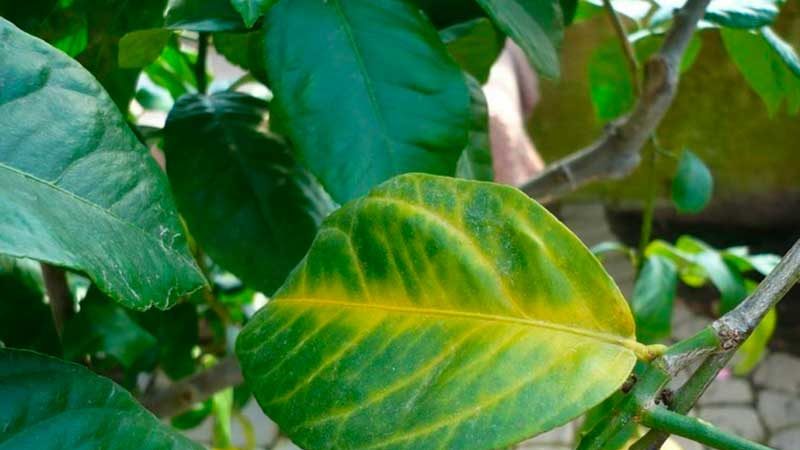

If the leaves begin to dry and fall off, but there is still greenery on the tree, then first of all, you should reconsider your departure and identify possible causes.
Sometimes it is enough to eliminate mistakes in care. This applies to cases where the citrus for a long time lacked light, fertilizers, transplanted into a new pot, or the air is not humid enough.
For other problems, the tree will have to be reanimated:
- Pouring soil. In this case, the lemon is removed from the soil. The roots are cleaned of the earth and examined. All rotten areas are cut off. The root system is dipped in a light pink solution of potassium permanganate and planted in a new disinfected soil, which is moistened with a small amount of a root formation stimulator. Temporarily reduce watering to 2-3 times a week. A small amount of liquid is poured under the root, sometimes adding a few drops of "Kornevin". The tree is sprayed daily, adding Epin to the water once a week. Such conditions are maintained until new leaves or shoots begin to form.
- Overdried soil. It is impossible to immediately water the lemon with a large amount of water, as this will provoke the shedding of the leaves. They begin to moisten the soil in small portions, pouring in 100 g of water every 2 hours. The next time the plant is watered every other day, also in small portions. Further, the usual scheme is used. To help the tree recover, it is sprayed twice a day for the first week, adding a little Epin to the morning solution.
- Stress after changing conditions, hypothermia, citrus recovery after a draft. To reanimate a lemon, it is transplanted into a new soil, poured with Kornevin solution and sprayed with Epin. They put a bag on a tree and put it in a well-lit place, but not in direct sunlight. The plant is ventilated daily for 10-15 minutes and sprayed with a spray bottle. Once a week add to the water for spraying "Epin". Use bottom watering by pouring water into a sump under the pot. After the leaf fall stops, and new leaves or shoots begin to form on the plant, the duration of airing is gradually increased, and then the greenhouse is completely disassembled.
Advice! Indoor lemon will recover faster if artificial lighting is used.
Symptoms
You can understand about the presence of problems with lemon by the appearance of the bush. It begins to wither, the leaves lose their glossy shine and begin to dry. By the nature of the tree's behavior, you can determine the source of the problem.
Blackening of leaf tips
The appearance of a dark area from the edge of the sheet plate is most often associated with low humidity and high temperature in the room. Excessive watering and the use of hard water leads to such a situation. The quality of penetration of the liquid into the ground should be checked; often the top layer is covered with a hard crust and does not allow it to penetrate inside.
Spots on the leaves
If the leaves turn yellow and dry from the end, then with a high degree of probability the plant has picked up an infection or pests overcome it. By the nature of the stains, you can determine the type of problem:
- with an invasion of the scale insect, the leaves are covered with yellow spots, which gradually grow;
- when affected by a tick, numerous small dots form on the leaf plates;
- with fungal diseases, yellow-brown formations are formed, eventually turning into scabs.
Problems most often arise when the soil was poorly treated before planting. For the fight, drugs with a special action against infections or pests are used.
Rolling the leaves
Curling of leaves can occur due to watering with cold water. In summer, this can be a reaction to hot weather and lack of air humidity. Often, an anomaly is observed with mineral starvation. To do this, it is important to understand which element is missing. This can be determined by the appearance of the twisted leaves:
- calcium - leaves lose color;
- magnesium - paleness is observed between the veins, the leaf plates acquire a variegated color;
- boron - leaves look withered, while watering does not change the situation in any way.
Twisting problems are also common in plants affected by spider mites and aphids.
Drying twigs and green leaves
Problems with the root system often lead to drying. This may be due to excessive watering and the beginning of decay of the processes. This situation can also indicate infection with a fungal disease or be a consequence of transplanting into a large pot, when the soil was selected incorrectly. To eliminate the risk of infection of the plant with a fungus, the plant should be treated with a fungicide.
Shedding color and fruit
If the lemon withers and sheds the fruit, then in this way it can react to a change of scenery. Regardless of the quality of care, when a plant is moved to a new location, shedding is likely to occur. The reasons for this situation may also be the inability of the tree due to its age to withstand the fruits, depletion of the soil, the plant's need for more lighting or watering.
Why does the subsidence occur and what to do?
If you notice that the leaves of homemade lemon have begun to turn yellow and fall off, then you should take a closer look at how exactly this happens.
This is because the nature of the yellowing can help determine what is causing it. Below is a complete list of how the leaves of a plant turn yellow and fall at home, why this happens and what kind of care the culture requires in this case.
For more information on why leaves fall and what to do to help the plant, read our article.
What makes the leaves turn yellow, dry and fall off?
If the leaves begin to turn yellow gradually, starting from the cutting and gradually spreading over the leaves, after which the leaf falls off, then you are dealing with one of the following situations:
- Bad light... The most likely option, especially in winter. To remedy the situation, you can rearrange the plant pot on the south window and surround it with several mirrors so that the light comes from all directions. It is possible to extend the "daytime" for the lemon with fluorescent lamps.
- Excessive watering... At the same time, the soil in the pot becomes dense and, naturally, does not allow air to pass through well. Because of this, small roots begin to die off and the plant does not receive enough oxygen, which means that the young shoots dry up and the leaves fall off. As a countermeasure, you can transplant the plant or loosen the soil in this pot and remember to move the plant to a warmer room, but not to the heaters.
- Insufficient watering... Due to a lack of moisture, the plant gets rid of small shoots that cannot be saturated with juice - small roots and part of the leaves. This only makes the situation worse. You can gently water the plant to correct the situation, the main thing is not to pour too much - this is very harmful.
- Sudden watering after a long drought... Basically, this is a combination of the two previous points.At first, the plant does not receive enough nutrition from the soil, and then, due to the large amount of water, the soil is compacted beyond any measure, which does not allow the roots to consume oxygen from the soil.
Watering after a drought should be gradual so that the plant slowly regains its shape. When the lemon comes to life a little, it should be transplanted into another pot, not forgetting to remove the dried or starting to rot roots. - Plant in winter by the battery... Lemons do not like dry air, and this is exactly what the included batteries and other heating devices have. If it is not possible to rearrange the plant, then you can periodically spray it from a spray bottle, or install a humidifier to the room.
- Watering with cold water... Almost all citrus fruits cannot absorb cold water, which leads to frostbite and death of some of the roots. And this leads to the death of the leaves. Therefore, before watering, the water should be heated a couple of degrees above room temperature.
- Heat... Despite the fact that citrus fruits love warmth, they do not tolerate high temperatures. This applies to both water temperature and air temperature. Too hot water will damage the roots, and too hot air can dry out the soil quickly.
- Lack of minerals... This situation is more or less standard and everyone knows what to do - purchase fertilizers and apply them to the soil. Again, the main thing is not to overdo it.
- Acclimatization... When acclimatizing a plant from stress and a sharp change in temperature, metabolism can be disrupted and the speed of movement of fluids can change, which can lead to the loss of part of the crown. Therefore, when transporting plants, you should not immediately put them in a warm or cold room (depending on the season).
For example, if you purchased a lemon tree in winter, then for the first time it is worth keeping it not on the windowsill next to the battery, but in a cooler place so that the temperature regimes change gradually.
If the leaves turn yellow at the base, and the tips look healthy, then in most cases this damage to the leaves is caused by poor drainage. To prevent water and air from stagnating in the pot, the surface of the earth should be loosened every few days. In addition, it is worth making drainage holes in the ground that go from the surface to the bottom of the pot.
Read about the reasons for the yellowing of foliage in this article, and what to do if the leaves dry from the end and around the edges, you can find out here.
How to understand that the cause is insects?


In addition to more or less natural reasons, changes in leaves can also be caused by harmful insects, which are especially attracted by the smell of citrus fruits. Below are the main pests of lemon trees and how they affect the leaves.
- Dark brown bumps appeared, the leaves turned yellow and began to fall off. Beetles are the cause of these leaf changes. These are either scutes or false scutes, which feed on plant sap, hiding behind small shields. Fighting these pests is difficult, but possible. From folk remedies, it is recommended to wipe the leaves with a soapy solution with the addition of alcohol. Or you can use special tools like Actellik.
- Turn yellow, curl, dry out. Spider mite. In some cases, small red bugs - spider mites - can be seen on yellowing leaves. In this case, it is necessary to use chemicals, such as the aforementioned "Actellic" or "Demitan".
- Yellowing of leaves, drying of whole branches and deformation of the leaves. The cause of such damage to the tree can be aphids - small, yellow-green bugs. To save the plant, you should either use soapy water or dichlorvos. To do this, a pot with a plant is packed in a tied bag, and a cotton wool soaked in the preparation is placed there. After four hours, the plant must be pulled out and its leaves must be rinsed with clean, warm water.
How to revive a tree
Reanimating a lemon tree is not easy. The main problem of how to revive a plant is to correctly determine the causes of what happened. If the lemon has dried up due to insufficient watering, then attempts are made to restore the root system. There is a certain algorithm of actions that will help you understand what to do in such a situation.
To begin with, the plant is removed from the pot, and the roots are soaked for 5 hours in a solution of "Heteroauxin".
First, you need to clear them from the ground and remove damaged processes. Next, the plant is planted in a pot, leaving the root collar 3 cm above the ground. Cover the crown with a plastic bag, providing further periodic ventilation. The soil is moistened with a nutrient solution. After 7 days the tree is sprayed with "Zircon" and the soil is watered abundantly
We saturate citrus with micro- and macroelements
You can revive the plant only when using high-quality soil. After transplanting within 2 months, the tree is not recommended to be fed with fertilizers. To prevent soil depletion throughout the year, the plant is fed with mineral and organic means. The following rules are recommended:
- in the spring, nitrogen-containing fertilizers are applied;
- in the summer, complex fertilizing is carried out at regular intervals;
- in the fall, nitrogen and organic matter are removed, the rate of potash fertilizers is increased.
When introducing the drug, the manufacturer's recommendations should be followed.
We take care of the plant correctly
It is important for a plant to ensure timely watering and periodically loosen the soil. In winter, it is good to provide additional lighting. Fertilizing the plant with mineral and organic fertilizers is carried out on a regular basis, focusing on the season.
Choosing the best place for the lemon
For placement, choose a sunny south side. The absence of a nearby heating system is desirable. The place must be protected from drafts and have a minimum passability.
We establish irrigation and regulate watering
Lemon needs moderate watering. This means that after the soil in the pot dries out, the soil is moistened not immediately, but only after 3 days. Air humidification and irrigation have a positive effect on plant growth.
We fight infections and insects
To prevent infection, use high-quality soil and once a year carry out preventive washing of shoots with soapy water. To combat lemon diseases, targeted drugs are used.
Why does a tree dry at home? What to do?


The most common cause of drying is the roots, or rather, their diseases. Improperly selected soil, excess moisture can create a favorable environment for the development of fungus that attacks the roots.
If the plant has been transplanted, then the new pot should be no more than 5 cm in diameter compared to the previous one. Otherwise, the soil will sour. And this again leads to decay of the roots. You can find the rules and recommendations for transplanting a lemon tree at home here, and from this article you will learn how to properly prepare the soil.
Leaves can dry out and in the presence of pests on the trunk and roots.
Too moving the pot frequently with a plant to new places can have a detrimental effect on its growth and vitality. Lemon simply begins to experience constant stress.
Dried up: how to revive?
If the reason for drying is a lack of watering and drying out of the soil, then the plant should be immediately pour over and cover with a plastic bag, providing him with greenhouse conditions.
You can also help lemon with a special fertilizer for the care of citrus fruits. Its introduction will give the plant additional impetus and strength.
Root rotting is caused by fungi, which can be destroyed by fungicides. After that, cut off the damaged parts of the root and sprinkle with crushed coal.
What to do with citrus after purchase so that it does not fly around
After purchase, the plant is freed from the packaging that fixes the roots. For an annual plant, take a container with a volume of 0.5-1 liters, for a two-year-old you can take 2 liters. A drainage layer is laid out at the bottom of the pot, the soil is covered and the roots of the tree are deepened, leaving the neck at the level of the soil. The plant is abundantly moistened and a layer of humus is formed on top of the soil. To reduce the level of stress, the lemon crown is covered with polyethylene or a glass cover. After a couple of days, spraying with "Epin" or "Zircon" is carried out.
Air humidity and temperature
It would seem that you took into account all the points for caring for the lemon, but the lemon leaves still turned yellow. What to do? Pay attention to the humidity level in the room. Excessive dryness of the air is another cause of discomfort for the plant. It will be optimal to maintain the humidity level in the range of 60-70%. After all, high humidity can lead to fungal diseases of the tree.
What measures should be taken? For summer or heating periods, you can place a lemon near a humidifier. If you don't have a humidifier, regularly spray the leaves with soft water at room temperature. You can also place various containers of water near the lemon. Experienced gardeners make a small greenhouse without a top for the plant: such a shelter will protect the plant not only from dry air, but also drafts.
Air humidity and temperature are two more important criteria, without which it will not be possible to grow a healthy lemon. Did you notice that the leaves of your lemon dry around the edges and curl? This means that the room where the plant is grown is too hot and dry air. Since lemon is a tropical plant, it does not tolerate excessive dry air very well.
Lemon can shed its leaves from excessive dry air and high indoor temperatures.
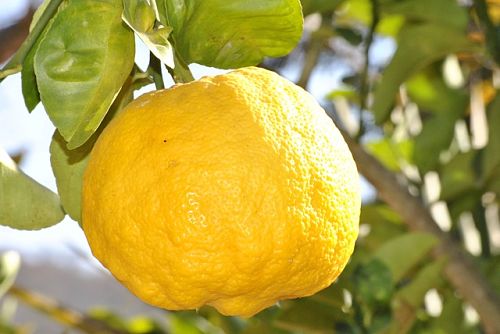

The optimum temperature for growing tangerine and lemon indoors is 20-23 degrees, and the humidity is at least 70%. You can use a humidifier to increase the humidity in your home to an optimal level. If it is not there, you can simply place containers filled with water near the plants. You also need to periodically spray the lemon with water from a spray bottle.
Cold and sudden changes in temperature can also be detrimental to the plant. Cold air can cause leaves to fall off the tree. Therefore, protect the lemon from drafts and cold.
Lack and excess of fertilizers
Citrus fruits are quite demanding on the presence of nutrients and trace elements in the soil. If small yellow spots appear on the leaves between the veins, then it's time to feed the lemon, otherwise the plant will die. Specialized citrus fertilizers are ideal for feeding. Although you can balance your diet yourself.
But keep in mind that in addition to phosphorus and nitrogen, your pet will also need preparations with magnesium, iron, zinc, potassium, calcium, sulfur. So if you are not a fan of gardening, then it is better to buy a ready-made fertilizer. An overdose of fertilizers can provoke the simultaneous fall of all leaves at once. Do not forget, if you want to calmly feast on the fruits without risk to health, adhere to measures in the use of dressings.
Folk remedies
When treating domestic plants, they try not to use chemical agents, because there are effective options for removing pests using natural remedies.
Solutions used to combat the pest:
- If the leaves of a room tangerine turn yellow, treat them with 1 p. in 7 days with garlic or onion juice with soapy water.
- Take 1 tsp. soap, melt in hot water, add 1 liter of water and 1 tbsp. l. alcohol (2 tbsp. l. vodka). Spray the whole tangerine with a mixed solution. It is better to cover the soil in advance. After a day, rinse with warm water. Repeat after 3-4 days.
- In the fight against the worm, a solution of garlic is effective. To prepare it, you will need 25-70 g of garlic.Clean it and mash, pour 1 liter of boiling water. Let the solution stand for 6 hours. Then strain the solution and spray the tree.
- Horsetail tincture is effective in the fight against the worm. Pour a little horsetail with boiling water and leave for 2 days. Water the tree with the resulting solution.
- To revitalize the tangerine, spray the tree with an olive oil solution. Mix 1 liter of water with 2 tbsp. l. olive oils.
- Use a tincture of calendula. Moisten a brush in it, smear the affected area. Do the procedures in the evening, hide the tree from the sun for 2 days.
If you find that the tangerine sheds leaves, you need to quickly remove the tree, to save neighboring indoor crops from the spread of the disease, since the pest can move on them. Inspect all nearby plants for a month every day. Treat the place where the damaged plant was located with a solution of alcohol and soap.
If the tree does not bloom, has lost all green leaves, has dried up, pistils have fallen off, a soap-kerosene emulsion, honey-soap solution, coniferous extract are also used (dissolve 2 tablespoons in 0.5 liters of warm water).

